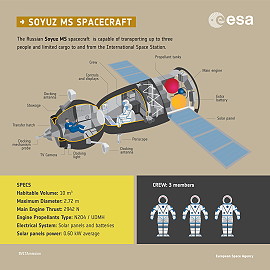Launch from the Baikonur Cosmodrome. Landing
32 km southeast of Dzhezkasgan.
It was intended to transport two members
of the
ISS
Expedition 57 crew to
the International Space Station. About 121.57 seconds after liftoff, the craft
went into contingency abort due to a sensor failure and had to return to Earth
into a "ballistic descent". Both crew members, were recovered alive in good
health. The
Soyuz MS-10 flight abort was the first instance of a
Russian manned booster accident at high altitude in 43 years, since
Soyuz 18A
similarly failed to make orbit in April 1975.
Aleksei
Ovchinin and Nicholas
Hague
had to protect 6.7 g forces. Other sources say 8 g.
The accident
occurred due to an abnormal separation of the first and second stages. One of
the side-mounted boosters during the separation did not take the right distance
and hit the second stage fuel tank, which led to the second stage breaking
apart. The reason for that, as the commission found out, was the abnormal work
of the sensor that signals the first and second stages of separation.
A
press conference was held on November 01, 2018 at the Mission Control Center at
TsNIIMash on the
results of the work of the State Commission to determine
the causes of the emergency situation that occurred on October 11, 2018
during the launch of the Soyuz-FG launch vehicle (Soyuz-FG) with a manned
transport ship (
Soyuz MS-10).
From the conclusion of the emergency
commission, Oleg Skorobogatov told the journalists about the results, "The
start ended with a PH accident due to the abnormal separation of one of the
side blocks (block "D") that hit the central block (block "A") in the tank
fuel, which led to its depressurization and, consequently, to the loss of
stabilization of the space rocket".
The reason for abnormal separation is
the failure to open the lid of the nozzle cover of the oxidizer tank of the "D"
block due to the deformation of the sensor of the separation contact sensor
(bending to 6°45') allowed when assembling the "bag" at the Baikonur
Cosmodrome. The cause of the RN accident is operational in nature and extends
to the groundwork collected in the "package" of the Soyuz type PH.
The
emergency rescue system of
Soyuz MS-10 worked in accordance with the established
logic. The crew acted in accordance with the requirements of the on-board
instructions and instructions of the Mission Control Center.
For the
unconditional implementation of the spacecraft launch plan for the Federal
Space Program and the programs of international cooperation of Russia, the
Roscosmos State Corporation organized the development of a set of measures to
exclude the possibility of an emergency situation repeating and carrying out
priority measures for the resumption of launches of the Soyuz-type launch
vehicle in November 2018. At the same time, the State Commission approved the
launch dates for the International Space Station program: on November 16, 2018,
the Soyuz-FG launch vehicle with the
Progress MS-10 transport cargo vehicle was launched,
and on December 03, 2018,
Soyuz
MS-11 was launched.
![]()



![]()


















